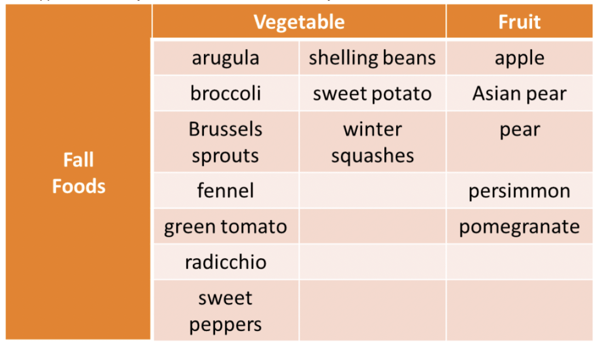Fall Food Primer: Fall Feasting & Preserving The Harvest
- Whether you decide to embrace autumn by attending local farms and festivals or by filling your house with the potpourri of aromas from in-season cooking or home-spun food preservation operations, this handout can provide you with a bounty of resources. Enjoy the ideas for savoring food this fall and for months to come.
Fall Food Chart
The following chart is a basic summary of commonly grown fruits and vegetables that make their debut in autumn. Regional specialties are not included in this chart, but you can find specifics by state at http://www.pickyourown.org/harvestcalendars.htm. Regional specialties add personality and opportunities to try new foods and dishes amidst your travels.

- To find local food options including farmer’s markets:
- Visit Local Harvest at http://www.localharvest.org/farmers-markets/ for a Find a Farmer’s Market locator tool by entering a zip code or state. This website also allows you to locate online stores, farms, CSAs (Community Supported Agriculture), restaurants, co-ops and meat processors. Descriptions of the farmer’s market as well as dates and hours of operation are provided.
- The United States Department of Agriculture maintains a directory of farmer’s markets and has a search tool at https://www.ams.usda.gov/local-food-directories/farmersmarkets
- www.farmersmarket.net. This resource also includes information on the Senior Farmer’s Market Nutrition Program (SFMNP) which provides low-income seniors with coupons for food at farmer’s markets, roadside stands and CSAs.
- To find fall festivals and events:
- Locate events at http://www.localharvest.org/events.jsp by specifying a distance within a zip code. The database of food-themed adventures can entertain you and your family for many weekend getaways.
Delayed Gratification: Reap Now, Enjoy Later
If the phrase “food preservation” conjures up images of your grandmother, you may have been asleep while the rest of the world is embracing a resurgence of modern-day food saving ideas. Saving seasonal flavors for later can wow your taste buds in the doldrums of winter, stretch your food dollars and provide a new culinary adventure. Consider some of the following ideas for inspiration:
Buy a food dehydrator…Food dehydrators can provide an easy entrance into the world of food preservation. You don’t need a food dehydrator to dry food, but it makes for an easier drying process than does an oven. A food dehydrator requires less electricity and oversight and provides the right amount of heat and maximum air movement. Almost any fruit, vegetable or herb can be dehydrated. Blanch vegetables and fruits before drying them to set their color and minimize flavor changes.
- Fruit leather: Puree any fruit and evenly spread a thin layer onto teflex or parchment lined food dehydrator trays. Dry at 115 degrees for approximately 3 hours or until firm. Flip and dry for another hour. Leather is done when able to peel from teflex or parchment without being sticky. Cut in shapes as desired and wrap individually or store in bulk in sealed container.
- Sweet potato bark: Peel 1 large (~13 ounces) sweet potato, cut into chunks and boil until soft; drain & mash. Add ½ cup unsweetened apple juice, 1 tablespoon maple syrup and 1 teaspoon cinnamon. Blend using a food processor or hand-immersion blender. Line dehydrator tray with parchment or teflex. Evenly spread sweet potato mixture onto lined tray ~ 1/8 inch thick. Dehydrate at 135 degrees for 6 hours; flip and dehydrate for another 1-2 hours without teflex or parchment.
Put’em up on Ice…Freezing is another easy option for preserving but it does ultimately incur more utility cost than dehydrating as well as the need for available freezer space. Vacuum sealers are great companions to the freezing process as removing air minimizes freezer burn. If you don’t have a vacuum sealer, remove additional air by slipping a drinking straw in one side of the opening, seal the bag up to the straw and suck the air out. Once the air is removed, pull the straw out and seal the bag.
- Bounty of Broccoli? Simmer broccoli in broth with chopped onion, celery, herbs and seasonings; puree and freeze to use later as a base for soups such as broccoli-cheese chowder on a cold winter night OR make freezer teriyaki bowls by adding blanched broccoli florets to brown rice, baked/grilled chicken strips, matchstick carrots and teriyaki sauce; combine, freeze and seal to create your own “fresh from the freezer” dinner.
- Peppers on Demand: To preserve sweet peppers for winter stir-fries, salads and sandwiches, halve sweet peppers, remove the core and seeds and slice into julienne strips or small 1/4" chunks. Pack into a freezer bag, remove the air and freeze. Frozen peppers are best used in dishes that are sautéed, such as stir-fries or added to onions and potatoes for a tasty omelet. When working with hot peppers, make sure to wear a pair of rubber gloves.
Worldwide Resources
Access more interesting and creative information available on this topic by exploring:
- National Center for Home Food Preservation http://nchfp.uga.edu/
- Food in Jars http://foodinjars.com/
- Punk Domestics http://www.punkdomestics.com/
- Canning Across America http://www.canningacrossamerica.com/
- Well Preserved http://wellpreserved.ca/

